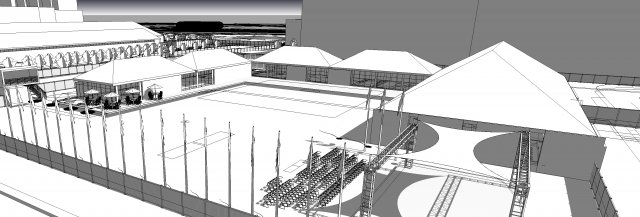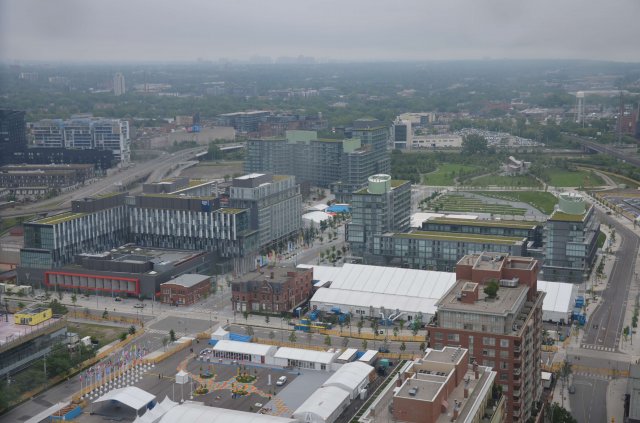When we started our special series “The Architects behind the Games” our goal was to showcase the often unnoticed behind the scenes work done by architects, intern architects, and architectural technologists to make international multisport competitions like the Toronto 2015 Pan Am/ Parapan Am Games possible. Few of our members can be considered more “behind the scenes” than the many architects and intern architects that worked inside the Toronto 2015 Organizing Committee. In this Q&A, Ontario architect and Senior Manager Overlay Design and Delivery Liza Stiff tells us about her unique contribution to the Games and how her experience as an architect contributed to the success of Toronto 2015.
In July 2013, Liza joined the Toronto 2015 Pan and Parapan American Games Organizing Committee as the Senior Manager Overlay Design and Delivery planning the Athletes’ Village. Liza graduated with a Bachelor of Fine Art, Printmaking, from Queens University in 2000 and completed her Master of Architecture at the University of Toronto in 2006. Before joining the Games she worked in numerous practices, including Todd Williams Billie Tsien Architects (TWBTA) in New York, Lewis + Hickey Architects in Dublin, Ireland, as well as Ontario based practices gh3 and Diamond Schmitt Architects.
Why did you decide to work for Toronto 2015 Pan Am/ Parapan Am Games? I was excited to work on a project that would be significant for my city. Architecture is a s-l-o-w process, which is not a bad thing, however I was stuck in a rut and needed something fast paced. I wanted to hit the ground running. The Village in any games is a special place, a home away from home, and I was interested in the idea that Toronto’s Village was exemplary of my home town. I very quickly grew attached to the idea that the success of this Village would be because it was a microcosm of Toronto and would showcase the city on an international stage.
Could you please describe your position? What is a typical day in the office like?
My role evolved over the duration of the project, graduating from:
i/ a typical office setting (where I was functioning primarily as a project architect and lead planner, working on paper) capturing games movements in drawings and planning for implementation with an enormous consortium of stakeholders; to
ii/ working with Infrastructure Ontario representing the athlete perspective, working with partners at the City, Dundee Kilmer, Ellis Don to plan for implementation; to
iii/ working through procurement professionals, scheduling the project phases, staging and construction, while also working with the fire chief, the police and municipalities to assure necessary regulations were met and to educate the municipal and provincial staff on Games’ requirements; and to
iv/ working through the building permitting and inspection processes for the temporary structures, and then acting as the general contractor (site supervisor) for the installation and delivery of the temporary structures.
Design - Plan - cost– procure – plan - schedule – execute – hand back - this has taken place over the last two years.
What are some of the similarities/differences of this job compared to working at an architectural firm? Similarities: tools of design, permitting process, project management, stakeholder coordination.
Differences: hands on, managing construction, keeping the peace – practical, ‘in-the-field’ problem solving, understanding contract administration from the builders’ point of view.
Are there many other architects or intern architects working “behind the scenes” for the Games? If so, what kind of work are they doing? There are many intern architects and a number of licensed architects working within the overlay department of TO 2015. Many had roles in design and planning of venues and overlay installations and then transitioned to site managers (similar to my role above) managing construction sites prior to the Games.
How does being an architect help you lead the process of designing the venue overlays? Let me start by explaining the term overlay and its primary role in event architecture. In a major international Games like the PanAm / Parapan Am, there are many client groups that have spatial requirements and proximity (flow) requirements which the venues are not otherwise built or equipped to handle. Key examples of these major client groups are International Olympic Committee compliant security installations and broadcast infrastructure for domestic and international broadcasters. In a sporting event, the flow of people (accredited or none accredited) and the time sequences associated with these flows are critical. In many cases the movements (flows) of certain populations (ie. residents within the Athletes’ Village who all have the highest level of accreditation) have to be completely isolated for various types of program (moving between the transit mall and the residential zone) to be sure there would be no security breaches. How buildings are designed, for their typical legacy program or use, are not necessarily how they will be used during a sporting event or ‘Games’.
For example, we designed and built probably the largest restaurant in Toronto this summer. It sat 2,500 people at one time. It was 40m x100m with a 20m x 85 m supporting kitchen. We are currently deconstructing the site including the dining hall.
 What has been your most challenging issue(s) during the preparatory phase? Are there unique challenges with the Athletes Village?
What has been your most challenging issue(s) during the preparatory phase? Are there unique challenges with the Athletes Village? Education (teaching people about the specific ‘time constrained’ requirements and performance levels associated with the Games) has been one of our most challenging issues. What we are doing is so specialized to events it takes a lot of communication and education to get people onboard. For example, presentations to fire officials, to police, to contractors, city planning and building divisions (examiners), to the residents of the surrounding community, to elected officials, to Games partners (sponsors or participants) needed to be coordinated to assure everyone understood what was being proposed, the impact on them, and what was being asked of them. This applies even to internal stake holders within TO2015. It takes extreme cooperation and trust to pull off a major Games build. Communication was, and is, key.
The most unique challenge was taking accessibility to the next level. I mean beyond the Accessibility for Ontarians Act (AODA). The Village needed to comply both with AODA, the IPC (International Paralympic Committee) Standards, and international best practices. We had a village with about 600 wheel chair users in one place. That is pretty incredible.
What has been your greatest accomplishment(s) so far with TO2015? Our village has been likened to an Olympic Village in terms of quality of space and the operations. This isn’t typically the case for Pan American Games Villages. The fact that we (TO 2015) had remarkably few issues, with either the facilities or the operations, during the Games is a testament to the quality of the work put in before the Games and to the quality of design. The overall performance of the Village was a huge accomplishment. Finishing this project on time was also a great accomplishment… although people only ever hear about it if you miss your deadlines!
Any key learnings or takeaways from this Games experience? Communication and diplomacy is key to project success. There is always another side to every story or issue and being able to step back to gain perspective, and to see the site at-large as a working, living project from start to finish is key.
What do you think is the architectural legacy of the Games for Ontario? After the Games, Ontario is left with exactly what it set out to do- renewed infrastructure, a formerly derelict part of the City now newly animated with a brand new neighbourhood, and an immense energy surrounding sport. The Province built facilities which will benefit many communities. The distributed positive impact of the Games- with venues in 17 different municipalities and significant investments in places such as Welland, Milton, Markham, and Scarborough, will be the greatest legacy. This said, the GTA’s sports and recreational infrastructure (in terms of quantity of venues and state of repair) still lags well behind many urban areas across Canada and throughout ‘The Americas’. Even after the Games, I would still say that we are about one third of the way to having the optimal level of recreational and sports Infrastructure required in healthy, active communities.
What event are you most looking forward to at the Pan Am /Parapan Am Games? The Parapan Games. I had the pleasure to tour the village a few times with accessibility expert Brad McCannell, whom is currently working for the International Paralympic Committee. One of the tours took place was when the Village was deep in construction. Brad is a quadriplegic and requires a wheelchair for mobility. The team went to great lengths to prepare the site for our tour, going so far as to install temporary asphalt ramps into and out of unfinished buildings.
It was on this tour where I saw first-hand the importance of thoughtful design in creating accessible communities. We needed to be much more astute to every need and every inaccessible condition we were creating... AODA and the new Ontario Buidling Code are a step in the right direction, however we as designers need innovate and push the boundaries and get away from the mentality that simply meeting code is the best we can do. This is really going to hit home over the next decades with our rapidly expanding, and aging, population.
I’m writing this from my office in the Village and outside I can hear athletes using the streets to train and to play. They are thrilled to be representing their countries and, from the look of things, thrilled to be in Toronto. Yesterday we welcomed Argentina into the village. The Pan Am Games were the same, level of excitement with a couple of key differences. The Parapan Athletes seem to move through the village as complete teams. They seem so excited to be here and I am proud we can host them here in our city.
